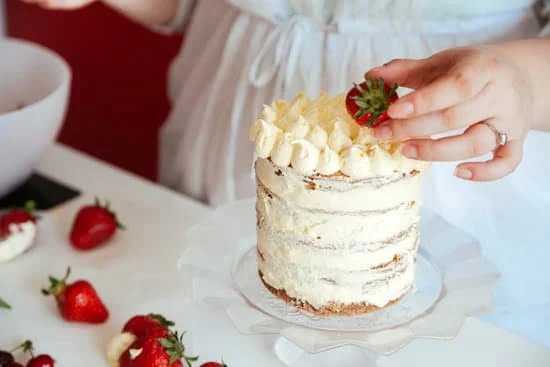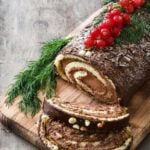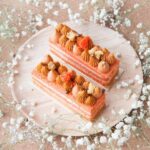Are you looking to add a touch of elegance and beauty to your baked creations? In this article, we will delve into the art of decorating flowers on a cake, exploring the impact that floral decorations can make. Whether you are a professional baker or an enthusiastic home cook, learning how to decorate flowers on a cake can elevate your creations to a whole new level.
Flower decorations on cakes have long been associated with special occasions and celebrations. From weddings to birthdays, anniversaries, and more, the addition of floral elements can instantly transform a simple cake into a stunning centerpiece. The right choice of flowers can complement the overall design of the cake and create a sense of sophistication and charm.
Choosing suitable flowers for cake decoration is crucial in achieving the desired aesthetic. With our step-by-step guide, we will explore different types of edible flowers that can be used for cake decorations and provide tips on selecting the best ones for your specific cake design. Additionally, we will provide insights on preparing the flowers for decoration, offering valuable advice on cleaning, trimming, and ensuring they are safe for consumption.
Choosing the Right Flowers
When it comes to decorating cakes with flowers, choosing the right blooms is crucial to achieving a beautiful and safe result. There are numerous types of edible flowers that can be used for cake decorations, each with its own unique characteristics and flavors. Before selecting flowers for your cake design, it’s important to consider factors such as color, size, and compatibility with the cake’s flavor profile.
Types of Edible Flowers
There is a wide variety of edible flowers that can be used to decorate cakes, including roses, lavender, violets, pansies, and more. Each type of flower brings its own distinct color and flavor to the table, allowing for endless creative possibilities when it comes to cake decoration. Some flowers have a subtle sweetness that pairs well with delicate cake flavors, while others may have a more intense or peppery taste that can add complexity to the overall dessert.
Selecting the Best Flowers for Your Cake Design
When choosing edible flowers for your cake decorations, it’s essential to consider how they will complement the overall aesthetic of the cake. For example, if you’re going for a classic and romantic look, roses or peonies might be the perfect choice. On the other hand, if you want to create a whimsical and colorful design, you might opt for daisies or pansies.
Additionally, it’s crucial to ensure that any flowers used for cake decoration are safe for consumption and haven’t been treated with pesticides. It’s best to source edible flowers from reputable suppliers or grow them yourself using organic practices.
Considerations When Using Edible Flowers
Before incorporating edible flowers into your cake design, take note of any potential allergens or sensitivities that your guests may have. Some individuals may have allergies to certain types of flowers or their pollen, so it’s important to communicate which specific blooms are used in your cake decorations. Additionally.
when using fresh flowers on cakes it’s important not only where they come from but ensuring they are 100% clean is crucial as well.
By carefully considering the type of edible flowers that will best complement your specific cake design along with considerations such as safety and cleanliness from harmful chemicals these tips should help ensure your flower decorated cakes are not only visually stunning but also safe for consumption by everyone at your celebration.
Preparing the Flowers
When it comes to decorating cakes with flowers, proper preparation of the flowers is essential to ensure they not only look beautiful but are also safe for consumption. In this section, we will provide a step-by-step guide on how to prepare flowers for cake decoration, including cleaning, trimming, and ensuring their safety.
Cleaning the Flowers
Before using any flowers for cake decoration, it is crucial to clean them thoroughly. This involves gently washing the flowers to remove any dirt, pesticides, or other contaminants. It’s important to use only organic flowers that have not been treated with chemicals. Once washed, the flowers should be allowed to air dry completely before being used on the cake.
Trimming and Preparing the Stems
Once the flowers are clean and dry, it’s time to trim and prepare the stems. Trim the stems of each flower to a suitable length for your cake design, taking into consideration the overall arrangement and height of the cake. Some stems may need to be removed entirely if they are too long or bulky. It is important to use clean shears or scissors when cutting the stems.
Ensuring Safety for Consumption
Not all flowers are safe for consumption, so it is vital to do thorough research before using them as cake decorations. The best practice is to use edible flowers that are specifically grown for culinary purposes. Avoid using flowers from florists or nurseries unless you are absolutely certain they are safe for consumption. Additionally, make sure there are no potential allergens present in the selected flowers that could affect anyone consuming the cake.
By following these steps for preparing flowers for cake decoration, you can ensure that your floral arrangements not only look stunning but are also safe for consumption and enhance the overall appeal of your cake design.
Types of Flower Arrangements
When it comes to decorating a cake with flowers, there are various techniques that can be used to achieve different arrangements. Each technique can create a unique and stunning look, adding an extra touch of elegance to your cake. Here are some popular types of flower arrangements for cakes:
1. Cascading Design: This arrangement is perfect for creating a dramatic and eye-catching effect on a tiered cake. Cascading flowers flow down the side of the cake in an organic or asymmetrical pattern, creating a romantic and ethereal look. To achieve this design, select long-stemmed flowers such as roses, orchids, or lilies and arrange them in a way that mimics a cascading waterfall.
2. Clustered Design: Clustered flower arrangements are ideal for adding a burst of color and texture to the top of a cake. This design involves grouping together several flowers in a tight cluster, creating a visually impactful focal point. It is important to use blooms of varying sizes and shapes to add dimension and interest to the arrangement.
3. Scattered Design: For those looking for a more understated and whimsical feel, the scattered design is a great option. This arrangement involves delicately scattering small blooms or petals across the top surface of the cake, creating a soft and romantic aesthetic. Consider using dainty flowers like baby’s breath, lavender sprigs, or rose petals for this design.
Achieving the perfect flower arrangement on a cake requires careful consideration of factors such as size, color, and placement of the blooms. Whether you opt for cascading, clustered, or scattered designs, each technique offers its own charm and visual appeal.
Incorporating these flower arrangement techniques into your cake decorating process can elevate the overall look and feel of your creation while adding personal flair and creativity. With some practice and experimentation, you can master these techniques to decorate flowers on your own cakes in no time.
Decorating Techniques
When it comes to decorating a cake with flowers, there are several different techniques for attaching the flowers to the cake. One popular method is using floral wires, which involves inserting a wire into the stem of the flower and then carefully placing it onto the cake. It’s important to note that when using this method, you need to ensure that the wire is food-safe and doesn’t come into direct contact with the cake.
Another option for attaching flowers to a cake is by using flower picks. Flower picks are small plastic or wooden sticks that can be inserted into the stem of the flower, allowing you to easily place them on the cake without damaging the delicate petals. This method is particularly useful for creating a cascading or layered effect with your flower decorations.
For those who prefer not to use wires or picks, edible glue can also be used to attach flowers to a cake. Edible glue is made specifically for use in food decoration and provides a safe and secure way to adhere flowers to the surface of a cake. It’s important to choose an edible glue that is specifically designed for use on cakes and other edible creations.
In addition to choosing the right attachment method, it’s also crucial to ensure that the flowers stay fresh on the cake. One way to do this is by keeping the flowers refrigerated until just before they’re placed on the cake. This helps preserve their freshness and prevents wilting. Additionally, some decorators choose to insert small water tubes into the stems of certain flowers in order to keep them hydrated throughout their time on display.
It’s clear from these various decorating techniques that there are multiple ways you can adorn your cakes with beautiful blooms. By experimenting with different methods and being mindful of flower selection and placement, you can create stunning floral designs that will truly elevate your baked creations.
Color Coordination
When it comes to decorating flowers on a cake, one of the most important considerations is color coordination. The right choice of flower colors can greatly enhance the overall aesthetic of the cake and create a cohesive look that is visually appealing. To achieve this, it’s essential to consider the color scheme of the cake’s design and select flowers that complement it.
To choose flower colors that work well with the cake’s design, start by taking into account the color palette of the cake itself. Consider the frosting or icing colors, as well as any decorative elements or patterns that are already present on the cake. Once you have a good understanding of the existing color scheme, you can then choose flowers that will harmonize with these colors.
Another important factor to consider when selecting flower colors for cake decoration is the overall aesthetic you want to achieve. For example, if you’re going for a romantic and elegant look, you might opt for soft pastel shades like light pink, lavender, or pale yellow. On the other hand, if you want to create a vibrant and eye-catching design, bold and bright flower colors like red, orange, or hot pink can be a great choice.
In addition to choosing flowers based on color schemes and overall aesthetics, it’s also important to consider how different flower colors work together. Some color combinations naturally complement each other, while others may clash or compete for attention. Experimenting with different combinations and considering color theory can help in achieving a cohesive and visually pleasing look when decorating flowers on a cake.
| Flower Color | Aesthetic |
|---|---|
| Soft pastel shades (light pink, lavender, pale yellow) | Romantic and elegant look |
| Bold and bright shades (red, orange, hot pink) | Vibrant and eye-catching design |
Additional Decorative Elements
When it comes to decorating cakes with flowers, there are many ways to enhance the overall look and make the design truly stand out. In addition to using edible flowers, incorporating other decorative elements can add depth and visual interest to the cake. Here are some suggestions for how to make the flower decorations on your cake even more stunning:
- Foliage: Adding foliage such as delicate leaves or greenery can complement the flowers and create a more dynamic arrangement. Whether using fresh or edible foliage, carefully placing these elements around the flowers can elevate the overall design.
- Herbs: Utilizing herbs like rosemary, lavender, or mint can not only add a pop of color but also infuse subtle aromatic notes into the cake. These natural accents can bring an earthy and organic feel to the floral decorations.
- Non-Edible Embellishments: While it’s important to ensure that all elements on the cake are safe for consumption, non-edible embellishments such as decorative ribbons, pearls, or jewels can be strategically placed among the flowers to add a touch of glamour and elegance.
These additional decorative elements provide endless possibilities for personalizing your cake design, making it truly unique and tailored to your specific taste and style. By carefully selecting and incorporating these elements in a thoughtful way, you can take your flower-adorned cake to the next level.
It is important to note that when incorporating non-edible embellishments on a cake, it’s crucial to inform guests which elements are safe for consumption. This ensures that everyone can enjoy both the visual beauty and delicious taste of your beautifully decorated floral cake without any concerns. With attention to detail and creativity, these additional decorative elements will enhance the overall aesthetic of your flower-adorned masterpiece.
Finishing Touches
After carefully selecting and preparing the perfect flowers for your cake, it’s time to put the finishing touches on the decorations to ensure a polished and professional look. Adding greenery is a great way to enhance the overall design and create a more natural and cohesive arrangement.
Look for edible greens that complement the flowers you’ve chosen, such as mint leaves, lemon balm, or small herb sprigs. Carefully place them among the flowers to add depth and texture to the decoration.
Adjusting the placement of the flowers is crucial in achieving a balanced and visually appealing design. Take a step back and assess the arrangement from different angles to make sure that no one area looks too crowded or sparse. Consider varying the heights of the flowers to create visual interest, and be mindful of symmetry if that’s what you’re aiming for.
To ensure that your cake looks polished and professional, take some time to fine-tune any details that may be out of place. This could mean adjusting individual petals or blooms, ensuring that there are no visible stems or wires, and checking for any crumbs or smudges on the frosting around the flower decorations. Remember that even minor imperfections can detract from an otherwise beautiful cake, so investing some time in these final touches can make all the difference.
By following these tips for putting the final touches on your flower decorations, including adding greenery, adjusting flower placement, and ensuring a polished appearance, you can elevate your cake decorating skills to a professional level. These extra steps will help showcase your attention to detail and commitment to creating stunning floral arrangements on cakes. With practice and patience, you’ll be able to create show-stopping cakes that are sure to impress any audience.
Conclusion
In conclusion, the art of decorating flowers on a cake is a beautiful and elegant way to add a touch of natural beauty to any special occasion dessert. From choosing the right edible flowers to selecting the perfect color coordination and arranging the blooms in various techniques, there are endless opportunities to create stunning floral cake decorations. Additionally, incorporating additional decorative elements like foliage and herbs can further enhance the overall aesthetic of the cake.
When it comes to finishing touches, it’s essential to take the time to ensure that the flower decorations are polished and professional-looking. Adjusting the placement of the flowers, adding greenery, and securing them properly will contribute to a visually appealing final product. Learning how to decorate flowers on a cake is an enjoyable skill that can be honed over time with practice, experimentation, and creativity.
We hope this blog post has provided you with valuable insights into the world of cake decoration with flowers. Armed with these tips and techniques, we encourage you to try your hand at decorating your own cakes with beautiful blooms.
Whether it’s for a special celebration or just for fun, creating floral cake decorations adds a personal touch that is sure to impress your family and friends. With proper preparation, careful attention to detail, and a bit of creativity, you’ll be well on your way to mastering the art of adorning cakes with stunning flower decorations.
Frequently Asked Questions
How to Decorate a Cake With Flowers?
Decorating a cake with flowers involves a few key steps. First, choose edible flowers that are pesticide-free and safe for consumption. Then, gently wash the flowers and let them air dry. Next, place the flowers on the cake either in a cluster or cascading down the side, securing them in place with frosting.
Can You Stick Flowers Directly Into a Cake?
It is not advisable to stick flowers directly into a cake as this can introduce harmful bacteria from the stems into the cake. Instead, use flower picks or food-safe stems to insert into the cake before placing the flowers on top.
How Do You Arrange Fresh Flowers on Top of a Cake?
When arranging fresh flowers on top of a cake, start by selecting small blooms that are pesticide-free and safe for consumption. Trim the stems to about 2 inches in length and insert them into food-safe straw or flower picks before placing them on the cake.
Arrange them in a visually appealing way, ensuring they are securely anchored to avoid any falling onto the cake during serving.

Welcome to our cake decorating blog! My name is Destiny Flores, and I am the proud owner of a cake decorating business named Cake Karma. Our mission is to provide delicious, beautiful cakes for all occasions. We specialize in creating custom cakes that are tailored specifically to each customer’s individual needs and tastes.





